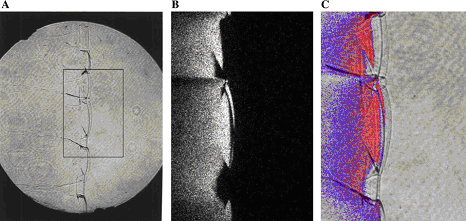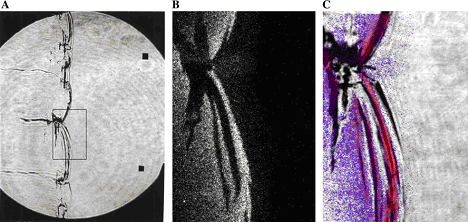
|
BRHS /
Detonation stability (Austin)Gaseous detonations propagating close to the Chapman-Jouguet (CJ) velocity all have unstable fronts, and there is a large body of work (Voitsekhovskii et al. 1966, Strehlow 1964, Oppenheim et al. 1968, Urtiew 1970, Edwards et al. 1972) documenting the common features of oscillations in the main shock strength, weak shocks moving transversely to the main front, and the quasi-periodic or cellular nature of the disturbances. These features are particularly prominent in mixtures with large amounts of monatomic gas dilution.  Figure 1. Images of detonation front propagating from left to right in 2H2-O2-12Ar, P1 = 20 kPa in the narrow channel. (A) Schlieren image. The box shows the location of the corresponding OH fluorescence image shown in (B). (C) Super-imposed schlieren and fluorescence images (the false color is a function of the intensity of the signal). PLIF image is 60 mm high. Traditionally, the degree of detonation front instability has been classified by the regularity of the cellular structure as determined from soot foils by visual inspection (Strehlow 1969) and image analyses (Shepherd et al. 1986). As an alternative, one can use the distance from the longitudinal neutral stability boundary in reduced activation energy versus Mach number coordinates as a figure of merit to quantify the degree of instability. For hydrogen mixtures the activation energy is the dominant parameter. In the context of a single-step irreversible reaction rate, detonation waves are stable if the activation energy Ea is less than a critical value, which depends on the ratio of specific heats \gamma , chemical energy content Q/RT1 of the mixture, and overdrive factor f =(U/UCJ)2. Eckett (2000) showed that the one-dimensional neutral stability curve for f = 1 is independent of \gamma if expressed in terms of the reduced activation energy \Theta = Ea/RTvN where TvN is the temperature at the von Neumann state and the CJ Mach number, MCJ. Weakly unstable detonations occur in mixtures with stability parameters (\Theta \approx 5, MCJ \approx 4.6). In particular, this category includes detonations in 2H2-O2 with more than about 50% Ar dilution; these mixtures are well known to have very regular soot foil patterns. An image of weakly unstable detonation is shown in Fig.1.  Figure 2. Images of detonation front propagating from left to right in 2H2-O2-3.5N2, P1 = 20 kPa in the narrow channel.(A) Schlieren image. The box shows the location of the corresponding OH fluorescence image shown in (B). (C) Superimposed schlieren and fluorescence images. PLIF image is 30 mm high. N2-diluted 2H2-O2 mixtures with \Theta \approx 7 may be classified as moderately unstable. These mixtures have soot foil patterns that are less regular than those of the weakly unstable mixtures. A sample image of a moderately unstable detonation front is shown in Fig. 2. The mixtures such as H2-N2O-1.33N2 or H2-N2O-1.77N2 with \Theta \approx 11 may be classified as highly unstable. Austin J.M., Pintgen F., Shepherd J.E. (2005) Proc.Comb.Inst. 30, pp.1849-1857 << Detonation cell size | Content | Non-uniform mixtures detonations >> |